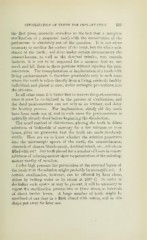Page 277 - My FlipBook
P. 277
STERILIZATION OF TEETH FOR IMPLANTATION. 249
the first place, reconcile ourselves to the fact that a complete
sterilization of a suspected tooth with the conservation of the
periosteum is absolutely out of the question. It is not alone
necessary to sterilize the surface of the tooth, but the whole sub-
stance of the tooth ; and since under certain circumstances the
cement-lacunffi, as well as the dentinal tubules, may contain
bacteria, it is not to be supposed for a moment that we can
reach and kill them in these portions without injuring the peri-
cementum. The transplantation or implantation of a tooth with
living pericementum is therefore practicable only in such cases
where the tooth is taken directly from a living, perfectly healthy
individual, and placed at once, under antiseptic precautions, into
the alveolus.
In all other cases it is better first to remove the pericementum,
since it must be devitalized in the process of sterilization, and
the dead pericementum can act only as an irritant, and delay
the healing process. For implantation, chiefly old dry teeth
have been made use of, and in such cases the pericementum is
naturally already dead before beginning the disinfection.
The usual method of disinfection, placing the teeth in dilute
solutions of bichloride of mercury for a few minutes or even
hours, gives no guarantee that the teeth are made absolutely
sterile. How are we to know whether the solution penetrates
into the microscopic spaces of the tooth, the cement-lacunse,
channels of chance blood-vessels, dentinal tubuli, etc. , which are
filled with air? Dry teeth placed for a number of hours in watery
solutions of coloring-matter show no penetration of the coloring-
matter worthy of mention.
Under high pressure the permeation of the external layers of
the tooth with the solution might probably be accomplished. A
certain sterilization, however, can be effected by heat alone,
either by boiling water or by steam at 100° C. In order to
devitalize such spores as may be present, it will be necessary to
repeat the sterilization process two or three times, at intervals
of about twelve hours. A large number of teeth might be
sterilized at one time in a flask closed with cotton, and in this
shape put away for later use.


